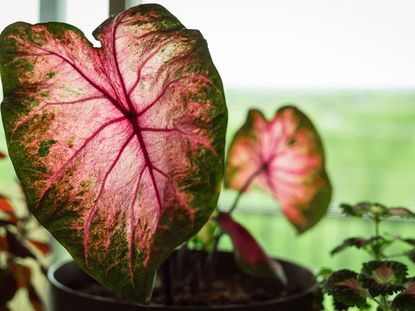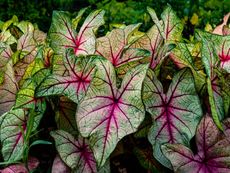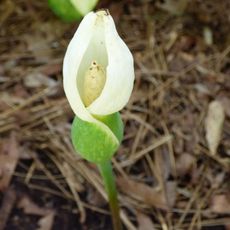How To Grow Caladiums Indoors: The Ultimate Care Guide
Growing a caladium indoors is a special treat for devoted houseplant parents. With its colorful shapely leaves and need for only indirect light, a caladium plant is a lovely indoor addition.


How To Grow And Care For Caladiums Indoors As Houseplants
Native to tropical regions of South and Central America, caladiums delight gardeners with their attractive patterns and vibrant colors. When grown annually, these plants can be found throughout the summer landscape in places that would otherwise be well outside of their hardiness range. Many lovers of this ornamental have also found success growing caladium indoors, as an attractive seasonal houseplant.
Quick Facts
Botanical name – Caladium
Height – 12-30 in. (30-76 cm.)
Spread – 12-24 in. (30-61 cm.)
Sun exposure – Part Shade, Full Shade
Soil requirements – Slightly Acidic
Hardiness zones – USDA Zones 8-10
When to plant – Spring
Can Caladiums Grow Indoors?
Though caladium plants are traditionally found growing outdoors in mixed beds and borders, they can also thrive in containers. Caladiums grown as houseplants are especially attractive and offer lasting color that brightens indoor spaces. However, they do require some special care in order to thrive indoors.
Caladium Indoor Care
Light
In the garden, caladiums grow best in beds that receive ample shade throughout the day. These same low-light conditions should also be maintained indoors. Potted caladium plants should be situated near a window where they can receive sufficient indirect light. When moving the pots to a new location be sure to monitor the plants carefully, noting any sign of light-related stress.
Water
Caladiums thrive with consistent moisture. During periods of active growth, the potted plants should be watered at least once each week when the surface of the soil has dried. As caladiums prepare for dormancy, reduce the frequency of watering. Once they’re dormant, potted caladiums do not require water until spring when a new growth cycle begins.
Gardening tips, videos, info and more delivered right to your inbox!
Sign up for the Gardening Know How newsletter today and receive a free download of our most popular eBook "How to Grow Delicious Tomatoes."
Temperature & Humidity
Warm temperatures and consistent humidity are essential to the health of this plant. Indoor caladium plants should be kept safely away from vents and/or any source of drafts within your home. Cooler temperatures may cause caladium to begin losing their leaves, or can even encourage dormancy. To maintain proper humidity levels it’s a good idea to do frequent misting. You can also place potted plants on shallow trays filled with rocks and water.
Soil
Though caladium plants appreciate consistent moisture, their soil should drain well. Caladiums will not tolerate soil that’s oversaturated or otherwise waterlogged. Most potting mixes are sufficient for growing caladium in containers. However, soil mediums specifically designed for use with acid-loving plants are also a good option.
Fertilizer
Though caladium plants are not considered heavy feeders, they do benefit from the use of a balanced, slow-release feed at planting time. Caladiums in pots require fertilizer more frequently. Monthly applications of a water-soluble feed are ideal to encourage the production of new leaves.
Problems, Pests & Diseases
Caladiums grown indoors only seldom have problems with pests. Still, watch for noticeable signs of damage caused by insects like aphids or mites. Plant stress is especially common among potted specimens. Causes of stress include temperature, as well as levels of light and moisture. Less-than-ideal conditions may cause yellowing, the premature loss of leaves, or even cause the plant to go into dormancy.
Pruning
If you’re growing caladiums indoors, you’ll need to prune them regularly. Remove dead or damaged leaves as they appear, helping to keep pots tidy and prevent disease. Clip back the plant's flowers as they appear, since allowing the plant to bloom can decrease its ornamental value. As caladium plants approach dormancy, their foliage will begin to die back. At this time, the entire plant can be cut back to soil level.
Repotting
After dividing the tubers, allow each segment to dry before planting them. During this time, the cut section will form a callus which helps protect the new plant against rot and other diseases. Tuber sections can then be planted into individual pots. After a thorough watering, move containers to a warm location where they are able to receive bright, indirect light.
Best Caladium Varieties to Grow Indoors
Here's a short list of some favorite indoor caladium varieties:
Dots Delight Caladium
Fiesta Caladium
Florida Fantasy Caladium
Icicle Caladium
White Lightning Caladium
FREQUENTLY ASKED QUESTIONS
Is Caladium a Good Indoor Plant?
Caladiums as houseplants are an excellent choice to add life and vibrancy to indoor spaces. Growing the plant indoors through the coldest months of the year is also a good option for overwintering your favorite plants.
Can You Keep Caladiums Indoors All Year?
Under ideal conditions, caladium can be grown indoors all year long. Both warmth and light are required throughout periods of active growth to keep the plants looking happy and healthy. Caladiums grown as houseplants will still require a period of rest or dormancy through the winter, lasting until new stems begin to emerge in spring.

Tonya Barnett has been gardening for 13 years. Flowers are her passion. She has trasformed her backyard into a cut flower garden, which she regularly chronicles on her YouTube channel http://www.youtube.com/@tonyawiththeflowers.
-
 Urban Beekeeping Guide: Top Tips For Raising Bees In The City
Urban Beekeeping Guide: Top Tips For Raising Bees In The CityUrban beekeeping can be a rewarding and appreciated pastime, but first be sure it’s legal in your city and learn the ropes of beekeeping.
By Mary Ellen Ellis
-
 2024 Plant Of The Year: Why Experts Say Philodendron Is The “It” Plant Of The Year
2024 Plant Of The Year: Why Experts Say Philodendron Is The “It” Plant Of The YearWe aren’t surprised that philodendron was designated the plant of the year. Versatile, easy-care and lovely, it’s the houseplant of the year 2024!
By Bonnie L. Grant
-
 What Is A Strap Leaf Caladium: Growing Strap Leaf Caladium Bulbs
What Is A Strap Leaf Caladium: Growing Strap Leaf Caladium BulbsCaladium foliage is celebrated by the warm-climate gardener as well as houseplant enthusiasts from all climates. Click here for more info.
By Mary Ellen Ellis
-
 Caladium Plant Problems – Caladium Plant Pests And Disease
Caladium Plant Problems – Caladium Plant Pests And DiseaseCaladium plants are very popular houseplants but they are not without their share of caladium plant problems. Click on the following article to learn about caladium plant pests and other problems with caladium.
By Teo Spengler
-
 Winter Care For Caladiums – Learn About Caladium Care In Winter
Winter Care For Caladiums – Learn About Caladium Care In WinterCaladium is native to South America. Because of this, it is used to hot temperatures and needs special treatment during winter in cooler climates. Learn more about storing caladium bulbs and how to care for caladium bulbs overwinter here.
By Liz Baessler
-
 Do Caladiums Bloom: What Is The Flower-Like Bud On Caladium Plant
Do Caladiums Bloom: What Is The Flower-Like Bud On Caladium PlantBlooming on caladium plants isn't common, but tubers planted in favorable locations tend to produce small flowers. There are several schools of thought on what to do with caladium flowers. This article will explain more. Click here.
By Bonnie L. Grant
-
 Tips For Growing Fancy Leaf Caladiums
Tips For Growing Fancy Leaf CaladiumsFancy leaf caladiums are a great addition to the often all-too-green shade garden. Before you grow fancy leaf caladiums, there are a few things you should know about them and their care. This article will help.
By Jackie Rhoades
-
 Grow Caladiums: Best Care For Elephant Ear Plants
Grow Caladiums: Best Care For Elephant Ear PlantsMulti-patterned caladiums are a firm favorite both in the garden and in indoor containers. Find out how to grow your own ‘elephant ears’ and get the most from these tropical beauties
By Tonya Barnett
-
 Planting Caladiums - When To Plant Caladium Bulbs
Planting Caladiums - When To Plant Caladium BulbsLast fall, you may have spent some time saving caladium bulbs from your garden and are now left with the question of when to plant caladium bulbs. The tips in this article can help with that.
By Heather Rhoades